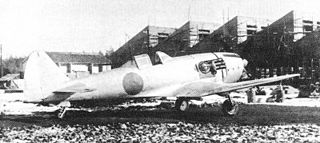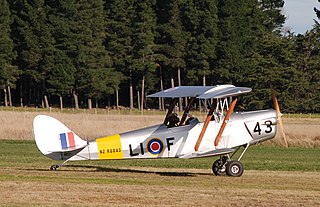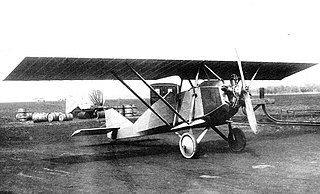Related Research Articles

The Vultee XP-54 Swoose Goose was a prototype fighter built by the Vultee Aircraft Company for the United States Army Air Forces (USAAF).

The Nakajima Ki-87 was a Japanese high-altitude fighter-interceptor of World War II. It was a single seat, exhaust-driven turbo-supercharged engined, low-wing monoplane with a conventional undercarriage.
The Gatard Statoplan AG 02 Poussin was a light, single-seat sports airplane developed in France in the late 1950s and marketed for homebuilding. In layout, it was a low-wing cantilever monoplane of short-coupled design with fixed tailwheel undercarriage. Construction was a plywood-covered wooden structure throughout, and the cockpit was enclosed by a large perspex bubble canopy. The variable-incidence horizontal stabiliser was fitted with small endplates to provide extra directional stability but there were no separate elevators.

The PZL M-17 "Duduś Kudłacz" was a Polish twin-boom pusher general aviation and trainer aircraft of 1977, which remained a prototype.

The Stearman M-2 Speedmail was a mail-carrier aircraft produced by the Stearman Aircraft Company of Wichita, Kansas. It first flew in January 1929. The Speedmail was a single-seat biplane, with two large cargo compartments in place of a front cockpit. The fuselage and tail unit were constructed from welded chrome-moly steel tube faired with wooden formers and fabric covered aft of the pilot's cockpit, and detachable aluminium alloy panels covered the fuselage forward of the cockpit. The wings were constructed from spruce spars and plywood built-up ribs, all fabric covered. It differed from previous Stearman aircraft by having a tailwheel instead of a tailskid due to its size and weight.

The Piel CP.70 Beryl is a French twin-seat, single-engine sport aircraft designed by Claude Piel. It was first flown in France in the 1960s and marketed for amateur construction.
The Piel CP.500 was a light aircraft of unusual configuration designed in France in the 1970s with the intention of marketing it for homebuilding. This did not transpire, however, and no prototype was actually built. It was a tandem wing design, somewhat reminiscent of the Mignet Pou-du-Ciel but considerably larger. Also, unlike the Pou-du-Ciel's unusual control system, the CP.500's pitch and roll control was to come from more conventional elevons mounted on the rear wing. The rear wing was also to carry endplate-style fins and rudders. Twin engines were to be mounted in push-pull fashion at the nose and tail ends of the fuselage, with the aircraft capable of single-engine operation in case of emergency. Two seats were to be provided at the front of the fully enclosed cabin, with a bench seat for three passengers behind them, plus an optional seat for a sixth occupant behind this. The undercarriage was to be of fixed, tricycle configuration. Construction was originally planned to be of wood, with engine cowlings and wingtips of composite construction. However, as development progressed, Piel considered metal as the main construction material.

The Fisher FP-404 is a Canadian single-seat, conventional landing gear, single-engined biplane kit aircraft designed for construction by amateur builders. Fisher Flying Products was originally based in Edgeley, North Dakota, USA but the company is now located in Woodbridge, Ontario, Canada.

The Fisher R-80 Tiger Moth is a Canadian two-seat, conventional landing gear, single engined, biplane kit aircraft designed for construction by amateur builders. The designation indicates that the aircraft is 80% the size of the aircraft that inspired it, the de Havilland Tiger Moth. Fisher Flying Products was originally based in Edgeley, North Dakota, USA but the company is now located in Woodbridge, Ontario, Canada.

The Smith DSA-1 Miniplane is a single-seat, single-engine sport aircraft designed in the United States in the 1950s and marketed for home building.

The Milholland Legal Eagle is an American high wing, strut-braced, single engine, tractor configuration, conventional landing gear-equipped ultralight aircraft that is available as plans from Better Half VW of Brookshire, Texas and also produced in kit form by J&N Bolding Enterprises of Baytown, Texas and intended for amateur construction.

The PWS-5 or PWS-5t2, was a multi-seated Polish liaison aircraft, developed in 1928 by PWS.

The Mitchell Wing A-10 and T-10 are a family of American cantilever, tricycle landing gear, high-wing, pusher configuration, one and two seat ultralight aircraft designed for amateur construction or supplied as completed aircraft. The aircraft were designed by Don Mitchell and were produced by a number of companies, the last being AmeriPlanes of Truro, Iowa.

The PWS 3 was a Polish sport aircraft, developed in 1927 by PWS, which remained a prototype.
The Dart Skycycle is an American single-seat, high wing, strut-braced, single-engine, conventional landing gear ultralight aircraft that was designed by Robert Dart and produced by Dart Aircraft of Mayville, New York for amateur construction.
The Sheffield Skeeter X-1 is an American single-seat lightweight homebuilt aircraft designed and built by Kenneth Sheffield of Littleton, Colorado. Designed for amateur construction only the prototype was built.
The Airborne Avenger is an American ultralight aircraft that was designed and produced by Airborne Wing Design in the early 1980s. The aircraft was supplied as a kit for amateur construction.
The EFF Prometheus was an unusual two seat motor glider powered by a pair of small turbojet engines, designed and constructed in Switzerland in the 1970s. Two versions with different spans were built, but it did not go into production.

The Bearhawk LSA is an American amateur-built light-sport aircraft, designed by Bob Barrows and produced by Bearhawk Aircraft of Austin, Texas. The aircraft is supplied in the form of plans or a kit for amateur construction.
The Vancil Spitz S1 is an American homebuilt aircraft that was designed and produced by A. Vancil of Belton, South Carolina, introduced in the late 1990s. When it was available the aircraft was supplied as a kit and also in the form of plans for amateur construction.
References
- Jane's All the World's Aircraft 1977–78. London: Jane's Publishing.
- Taylor, Michael J. H. (1989). Jane's Encyclopedia of Aviation. London: Studio Editions.
- MacDonald, Robert. "PLANS FOR THE MACDONALD S-21 AND S-22 AMATEUR-BUILT AIRPLANES". MacDonald S-21. Retrieved 3 October 2021.